When most people think of Idaho they likely think of wide-open spaces or potato farming. In truth, the Gem State is full of scenic vistas and home to many fascinating plants and animals. From wolverines to caribou, Idaho is literally teeming with interesting creatures. The state is also home to many different species of spiders. Here is a preview of 10 spiders in Idaho that you’re likely to see if you spend an extended period of time in the state.
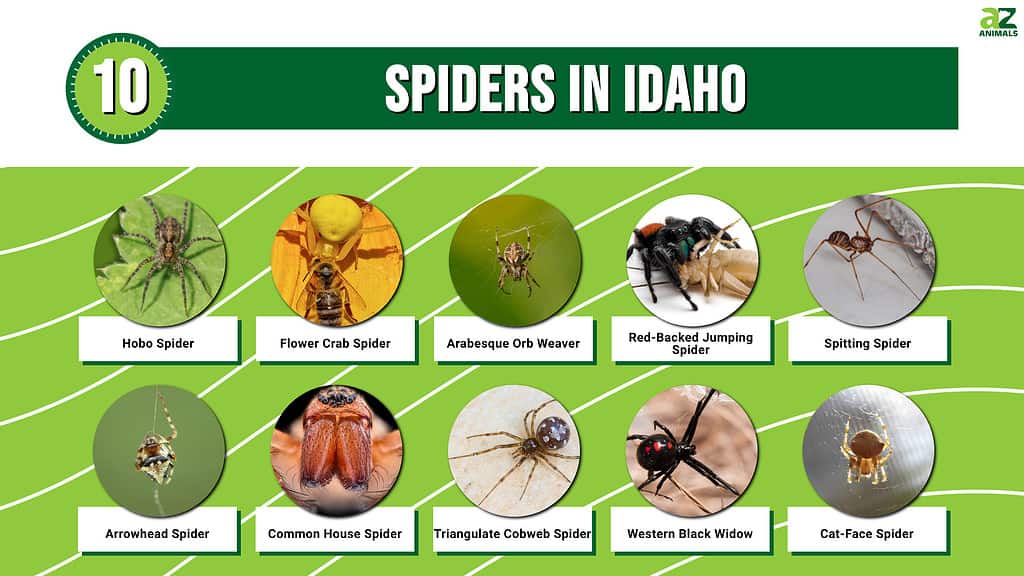
All spiders belong to the Class Arachnida, but the family tree branches out widely from there. We’ve identified the Family classification on each of these spiders for you and provided other details of interest. Read on!
#10: Cat-Faced Spider
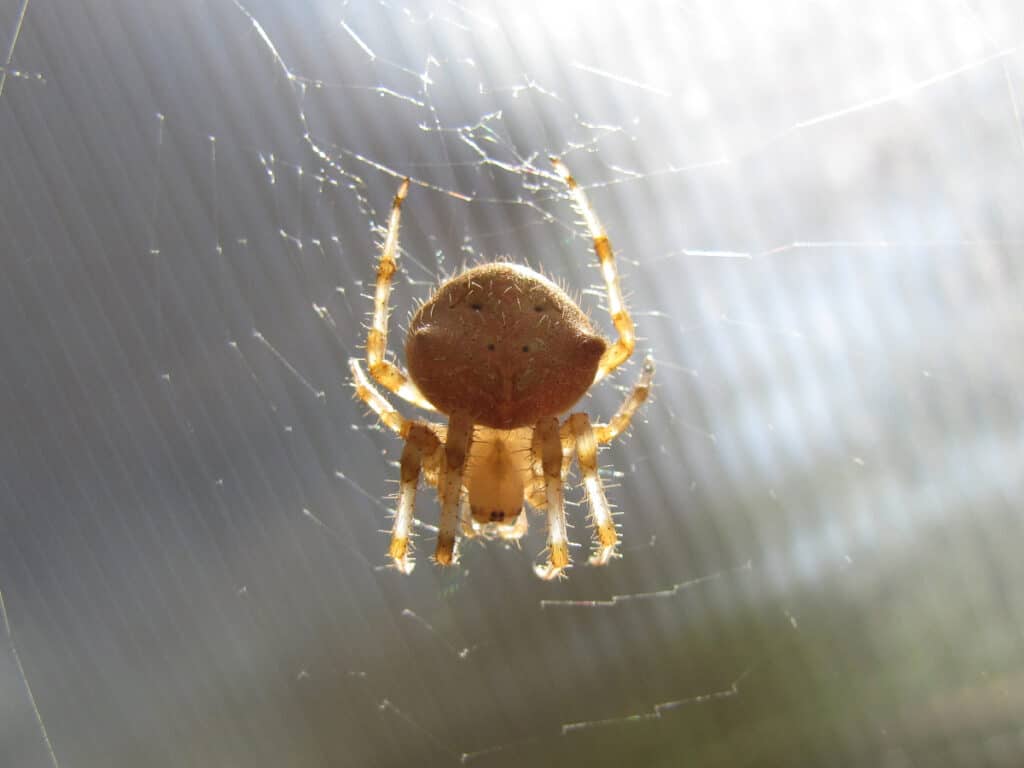
The cat-faced spider has an abdomen with large bumps that look like the face of a cat.
©iStock.com/TaosAnne
The cat-faced spider or jewel spider belongs to the orb weaver family Araneidae. This curious spider gets its name from its unusually shaped abdomen, which appears to resemble a cat.
Female cat-faced spiders measure 13 to 24 millimeters long and males measure 5 to 8 millimeters long. They come in a range of colors from light yellow to chestnut brown and feature light and dark brown bands on their legs. Their name comes from the appearance of their abdomens, which feature two horn-shaped growths and markings that look like the ears and face of a cat, respectively.
Cat-faced spiders build their webs in areas with plenty of sunlight such as walls along buildings, overhangs, and around woodpiles. They prey on many different insects considered pests to humans, so many people considered them useful. While dangerous to insects, their bite contains low venom levels and poses little risk to humans.
#9: Western Black Widow
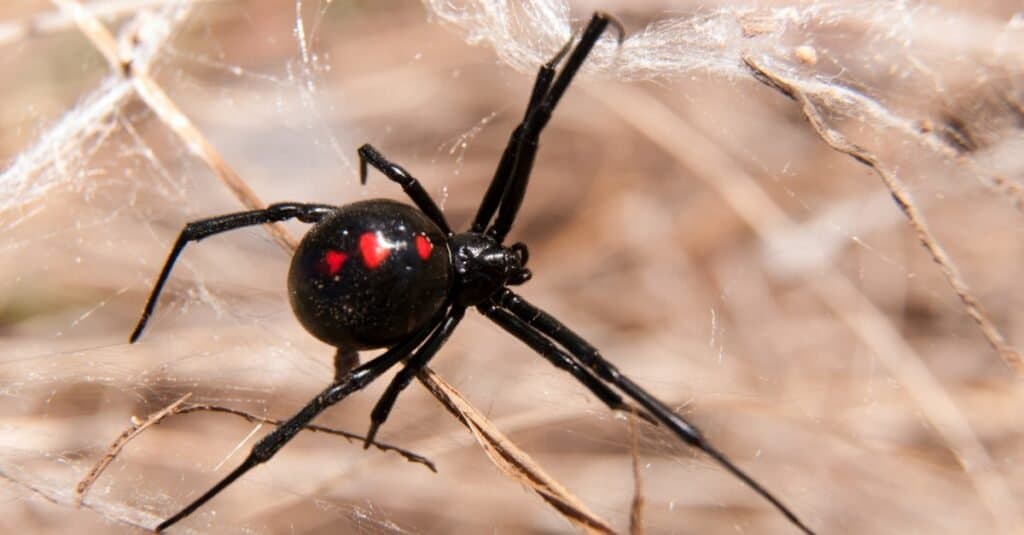
Black widow spider bites rarely kill people, but it’s important to get medical attention as soon as you can because they can make you very sick.
©Sari ONeal/Shutterstock.com
The western black widow is one of the most venomous spiders in Idaho. It is a member of the cobweb spider family Theridiidae and part of the “true widows” genus Latrodectus. You can find western black widows as far all along the western half of North America.
As is typical of black widows, western black widows appear predominantly black aside from their hourglass-shaped abdominal markings. These markings are typically red, but can also be yellow or white. Females measure from 14 to 16 millimeters long and males measure about half the size of females.
Unlike some species of widow, western black widows rarely engage in cannibalism after courtship. They build irregular cobwebs that include hanging threads lined with sticky glue designed to snag and entangle prey. Their venom contains a neurotoxin capable of causing pain, fever, and nausea. While rarely fatal, their bite can kill young or weak people.
#8: Triangulate Cobweb Spider

The triangulate cobweb spider features purplish-brown zigzag markings on its abdomen.
©Timelynx/Shutterstock.com
Also known as the triangulate bud spider, the triangulate cobweb spider is a member of the cobweb spider family Theridiidae. You can find these cosmopolitan spiders in Idaho as well as throughout North America, Russia, New Zealand, and Europe.
Female triangulate cobweb spiders measure 3 to 6 millimeters long, while males measure slightly smaller. They have a brownish-orange cephalothorax and thin yellowish legs. Meanwhile, their abdomens are quite bulbous and feature zigzagging purplish-brown lines from front to back, which is where they get their name.
Triangulate cobweb spiders prey on many different insects as well as spiders and ticks. In fact, they will even prey on spiders considered pests by humans such as brown recluses on hobo spiders. They build irregular webs – cobwebs – made of sticky threads that they use to trap prey. Their bite is not considered dangerous to humans and they rarely bite unless threatened.
#7: Common House Spider
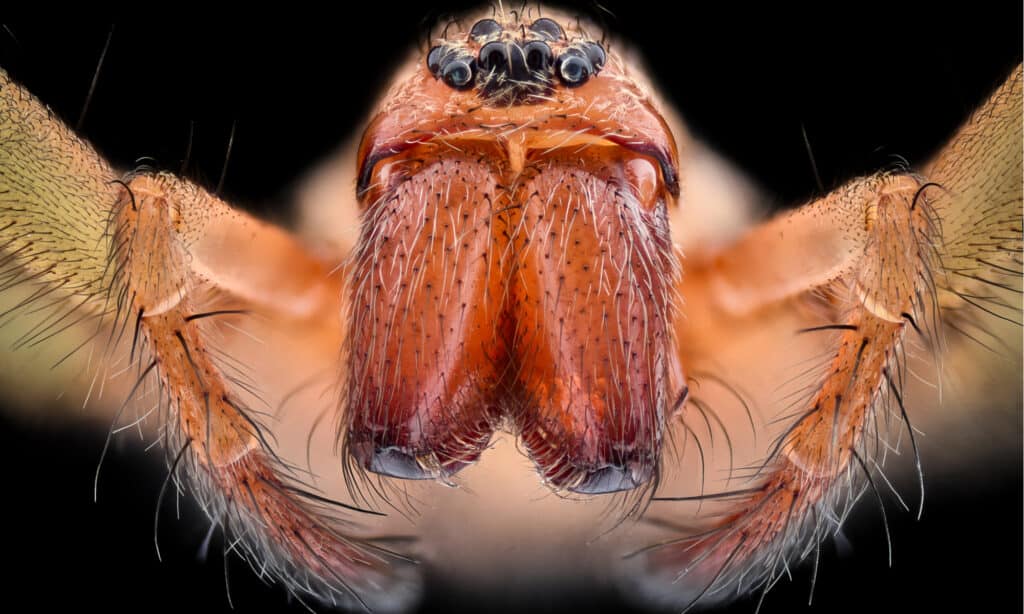
Common house spiders come in a wide range of colors and feature different types of markings.
©Cornel Constantin/Shutterstock.com
Also known as the American house spider, the common house spider is one of the most common spiders in Idaho. It gets its name from the fact that it is frequently found indoors or near human dwellings.
Female common house spiders typically measure between 5 and 6 millimeters long and males measure 4 to 5 millimeters long. In terms of appearance, they sometimes get mistaken for widow spiders due to their color, size, and shape. They vary in color from black to tan and feature an assortment of different markings on their bulbous abdomens.
Common house spiders build asymmetrical cobwebs that they use to catch insects including ants, mosquitoes, and wasps. They aren’t considered aggressive, although their proximity to humans does increase the likelihood of bites. While they possess neurotoxic venom, their bite is not dangerous to humans.
#6: Arrowhead Spider

The arrowhead spider gets its name from its irregularly-shaped abdomen that looks like an arrowhead.
©Rusty Dodson/Shutterstock.com
The arrowhead spider also goes by the names triangle orb weaver and arrowhead orb weaver. It is one of the most unique-looking spiders in Idaho due to its irregularly-shaped abdomen. You can find it across North America, particularly in humid habitats with plenty of sunlight.
Female arrowhead spiders measure 7 to 14 millimeters long and males measure around 4 to 6 millimeters long. They get their name from their triangle-shaped abdomen that looks conspicuously like an arrowhead. Their legs and carapaces can look black, brown, or red, while their abdomens are almost always yellow or white.
Unlike most orb weavers, arrowhead spiders sit facing upwards in their webs. Additionally, their webs differ from those made by other orb weavers because the central section lacks radial threads. While their webs are made of unusually strong silk, they usually take them down at day’s end to prevent them from getting damaged.
#5: Spitting Spider
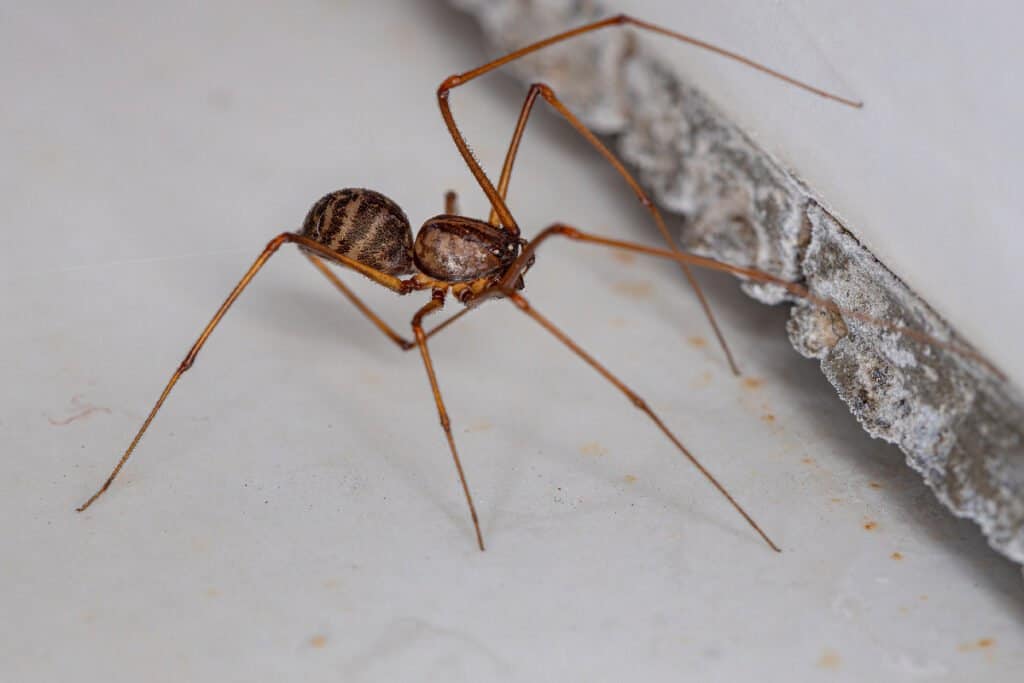
Spitting spiders catch prey with venomous silk.
©iStock.com/ViniSouza128
Spitting spiders belong to the family Scytodidae, which contains over 250 species. They range all throughout the world and live in various climates and habitats.
Unlike most other spiders, spitting spiders have 6 rather than 8 eyes. Additionally, they feature a dome-shaped carapace and typically sport long, slender legs. Their abdomens and carapaces normally look light brown or tan and are covered with dark markings. Most spitting spiders are quite small and measure only 3 to 6 millimeters long.
Spitting spiders catch prey in a unique way different from most other spiders in Idaho. Instead of building a web or catching prey on the run, spitting spiders shoot venomous threads. They fire their threads from about 10 to 20 millimeters away and then wrap up their entangled prey. Due to their small size, their bite poses little threat to humans.
#4. Red-Backed Jumping Spider
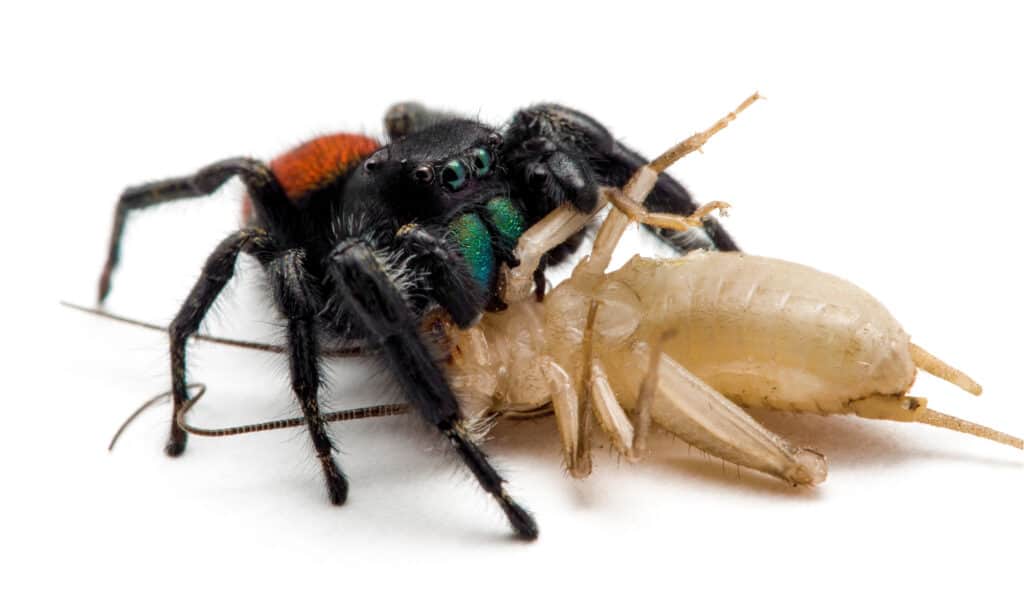
The red-backed jumping spider is one of the largest and most common jumping spiders.
©Ernie Cooper/Shutterstock.com
The red-backed jumping spider, Phidippus johnsoni, is one of the most common jumping spiders in Idaho. It can also be found throughout most of western North America, from Canada in the north to Mexico in the south.
Most red-backed jumping spiders measure around 10 millimeters long. As their name implies, they feature bright red abdomens, although only the females sport a black stripe in the center of their abdomens. Meanwhile, their mouthparts appear bright teal while the rest of their bodies are black.
Red-backed jumping spiders mimic velvet ants, which enables them to sneak up on the ants without arousing suspicion. During the day, they hunt by relying on their eyesight and agility. Common prey that they target include flies, moths, ants, and even other spiders. They rarely bite humans and their bite is not considered dangerous.
#3. Arabesque Orb Weaver

The arabesque orb weaver gets its name from its unique markings.
©Paul Reeves Photography/Shutterstock.com
Neoscona arabesca, or the arabesque orb weaver, is one of the most common orb weaver spiders in Idaho. It gets its name from the brightly colored, swirling markings on its abdomen. You can often find it in fields, gardens, or wooded areas that have suitable structures for it to build its web.
Female arabesque orb weavers measure 5 to 7 millimeters long and males measure 5 to 6 millimeters long. The curves and swirls that adorn their abdomens resemble arabesque artwork common in North Africa and the Middle East. They range in color from brown to orange to grey to black.
Like other orb weavers, they build large circular webs that they use to capture prey. Don’t be alarmed in the event you should accidentally walk into their webs. They generally don’t act aggressively, and their bite isn’t considered dangerous to humans.
#2: Flower Crab Spider
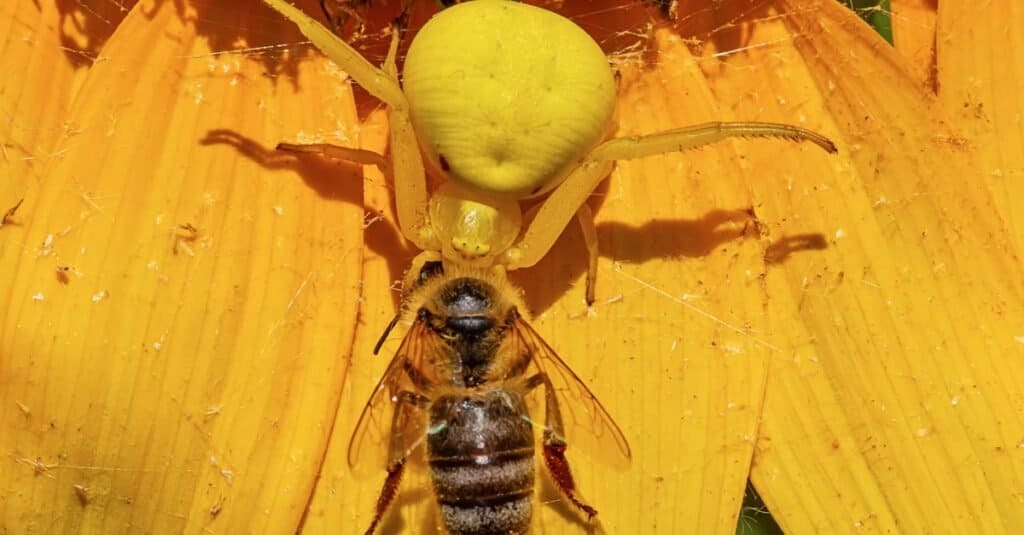
Flower crab spiders prey on insects that visit flowers.
©Nenad Nedomacki/Shutterstock.com
Also known as the goldenrod crab spider, the flower crab spider is a member of the crab spider family Thomisidae. It gets its name from its habit of hunting in goldenrod and milkweed plants. You can find these spiders in Idaho as well as throughout much of North America and Europe.
Female flower crab spiders measure around 10 millimeters long, while males measure no more than 5 millimeters long. They typically appear solid white or yellow or may feature a mixture between the two colors. Additionally, they possess the ability to change their color depending on their surroundings or the foods they eat.
Flower crab spiders don’t use webs to catch their prey, and instead rely on their keen eyesight and ambush tactics. They wait in flowers and pounce upon unsuspecting insects that come to feed on the nectar or to collect pollen. Although their venomous bite is enough to kill most insects they pose little threat to humans.
#1. Hobo Spider

Hobo spiders are believed to be venomous, but in reality, pose little threat to humans.
©SNEHIT PHOTO/Shutterstock.com
The hobo spider belongs to the funnel web spider family Agelenidae. Its name comes from its supposed method of disbursing by stealing away inside cars and trucks. This may explain its cosmopolitan distribution, as you can find these spiders in Idaho as well as throughout North America, Europe, Central Asia.
Most adult hobo spiders measure 7 and 14 millimeters long, with females measuring larger than males. They typically appear almost uniformly brown aside from several v-shaped markings running down their abdomens. Additionally, they often have a light stripe in the middle of their sternums.
Hobo spiders build funnel-shaped webs that they use to capture prey. They wait in the back of the funnel for prey to wander in and then rush forward to bite and immobilize their victim. While rumors abound that they are poisonous, their bite poses little danger to humans, although it may cause some pain and swelling.
Summary of 10 Spiders Found in Idaho:
The photo featured at the top of this post is © Cornel Constantin/Shutterstock.com
Thank you for reading! Have some feedback for us? Contact the AZ Animals editorial team.






